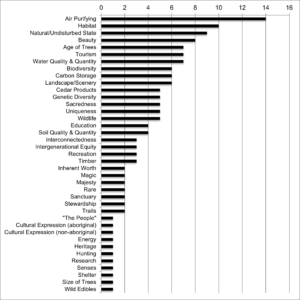Old-Growth Values of the Ancient Forest
LEARNING MODULE
Forest values we are referring to the features of a forest that contribute to human physical well-being, to the intangible benefits of a forest that contribute to the non-material dimensions of quality of life, and to the intrinsic benefits of a forest that exist independently of humankind.[1] In other words, we are referring to the things we value about forests.
Moyer and colleagues developed a framework specifically for assessing values of old-growth forests.[2] This framework combines the ways of valuing forests and the specific objects of value (e.g., timber and tourism). Based on people’s descriptions of values associated with old-growth forests in Eastern Canada, Moyer developed a value framework specifically for old-growth forests. Moyer’s Old-Growth Value framework specifies between four and six specific values for each of six categories, yielding a framework with 31 values.
This framework was further developed by Shapiro and colleagues for studying forest values associated with the ancient forest of BC’s inland temperate rainforest.[3] This old-growth forest is located in the watershed of the Upper Fraser River in British Columbia. The modifications were based on a content analysis of values generated by users of the Ancient Forest Trail who recorded their reflections about the forest in the trail guestbook.[4] Trail users frequently describe the ancient cedar forests as rare and unique and thus Shapiro included values in their framework that capture a variety of such qualities. Some of the specific terms used for these additional values were drawn from Moyer’s definitions. Recreation was identified as a separate category among non-material values. The modified framework includes values classified into seven value categories (Figure 1).
Figure 1. Ancient Forest Value Framework

The study of the ancient forest revealed that tocal residents identified a wide range of forest values associated with the ancient cedars as highly important to them. Of the 51 values given to participants, 39 different values were identified as important to at least one local resident (Chart 1). Of all the values selected by the respondents, the majority of values (39%) were life-support values, followed by aesthetic (19%), ethical (15%), economic/material uses (12%), spiritual (7%), socio-cultural (6%) and recreation (3%). Life-support values clearly emerged as extremely important to residents. Ninety percent of respondents selected at least one life-support value. The most highly endorsed life-support values were linked to fundamental ecological processes, air and water quality, and carbon storage; and to support of biodiversity, specifically habitat, wildlife, and biodiversity. Over 50 percent of respondents selected at least one aesthetic value and one-third of respondents selected at least one spiritual value. Among aesthetic values, the most frequently selected values included natural/undisturbed state (30% of the sample), beauty, and landscape/scenery. Among the spiritual values, sacredness was the most frequently selected (17% of the sample). Of the ethical values, two that are identified as values capturing the inherent worth of old-growth forests were selected most frequently: age of trees (23%) and uniqueness (17%). Among residents, there was great appreciation of a range of values beyond traditional timber values. With respect to economic values, timber values were identified as important to three residents (10% of the sample) and cedar products identified as important to five residents (17%). Tourism was identified as an important value (7 residents or 23%) more frequently than timber.
Chart 1. Most Important Ancient Cedar Stand Values

Media Attributions
- Figure 1. Ancient Forest Value Framework © Shapiro, J (2012). Forest values surround ancient cedar stands in British Columbia’s inland temperate rainforest. MA thesis, Natural Resources and Environmental Studies, University of Northern British Columbia, Prince George, BC. is licensed under a All Rights Reserved license
- Chart 1. Most Important Ancient Cedar Stand Values © Shapiro, J (2012). Forest values surround ancient cedar stands in British Columbia’s inland temperate rainforest. MA thesis, Natural Resources and Environmental Studies, University of Northern British Columbia, Prince George, BC. is licensed under a All Rights Reserved license
- Putney, A. D. (2003). Introduction: Perspectives on the values of protected areas. In The full value of parks: From economics to the intangible, ed. D. Harmon and A. D. Putney, pp. 3–11. Lanham, MD: Rowman & Littlefield ↵
- Moyer, J. M., R. J. Owen, and P. N. Duinker. (2008). Forest values: A framework for oldgrowth forest with implications for other forest conditions. Open Forest Science Journal 1:27–36. ↵
- Shapiro, J (2012). Forest values surround ancient cedar stands in British Columbia’s inland temperate rainforest. MA thesis, Natural Resources and Environmental Studies, University of Northern British Columbia, Prince George, BC. Connell, David J., Jessica Shapiro, and Loraine Lavallee (2015). Held Forest Values of the Ancient Cedars of British Columbia. Society and Natural Resources 28(12): 1,323-1,339. ↵
- The Ancient Forest Trail is now part of the Ancient Forest/Chun T’oh Whudujut Provincial Park. ↵


Feedback/Errata